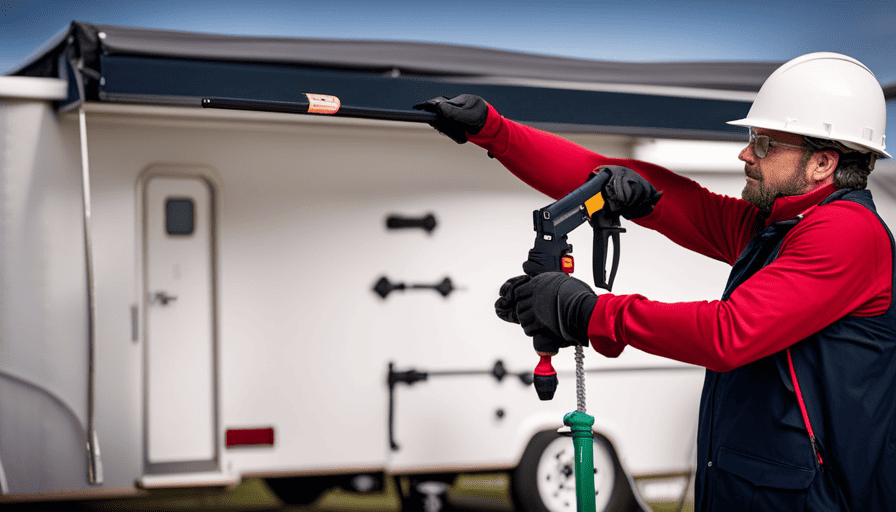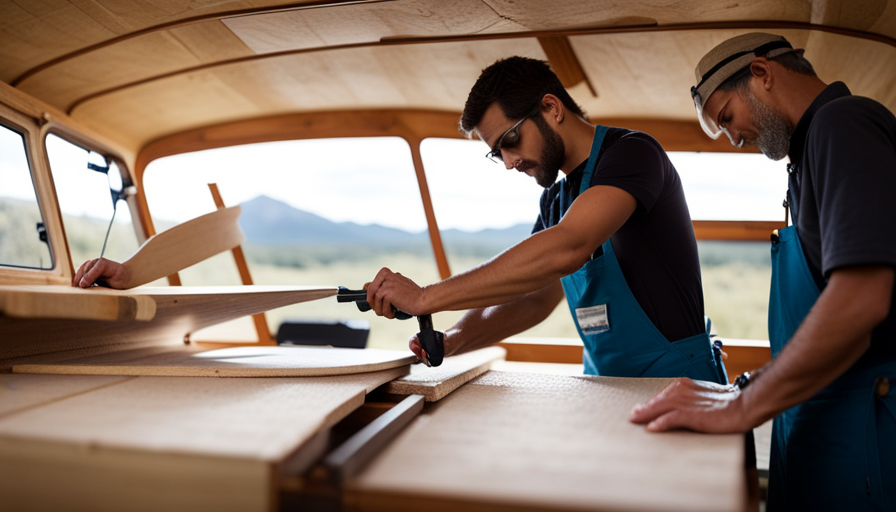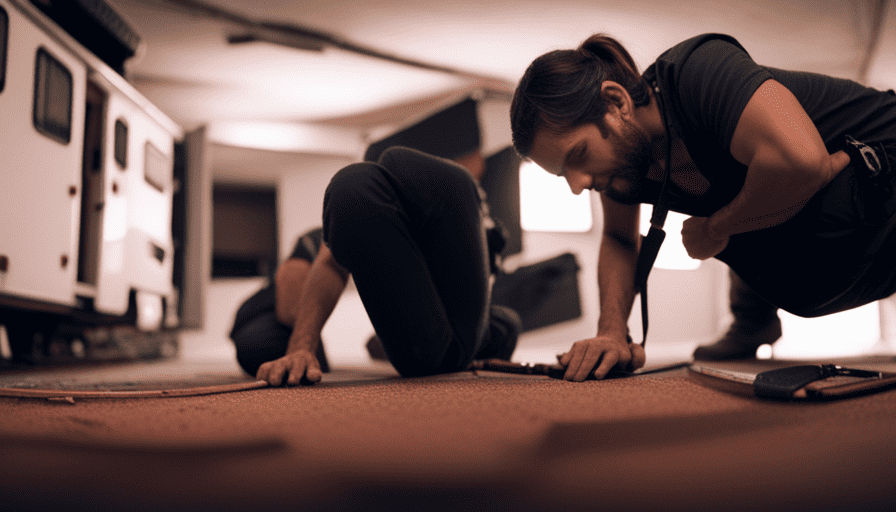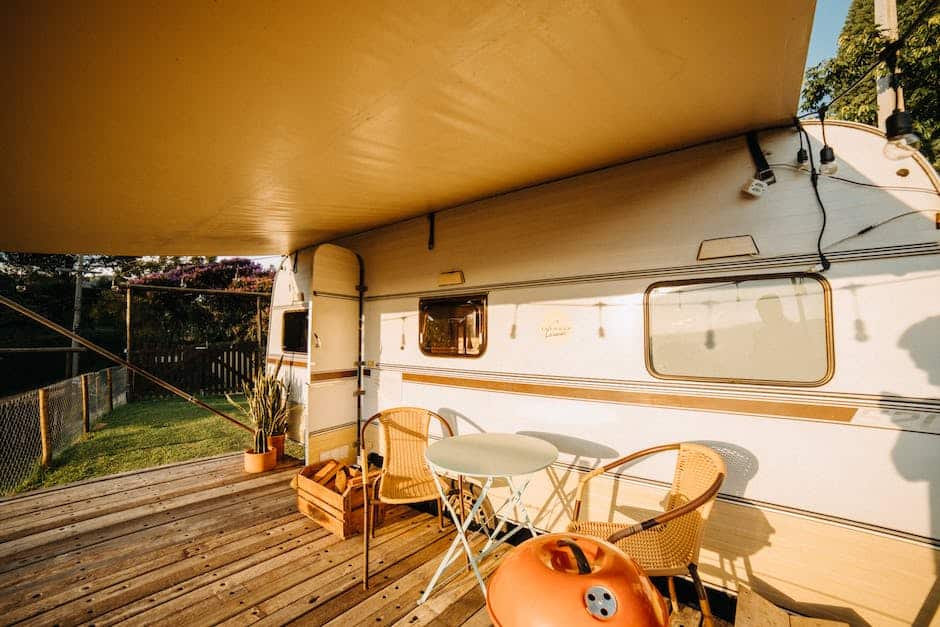You’ve decided to venture out with your pop-up camper for a weekend escape, only to find out there’s a leak in the roof. It’s annoying, for sure. However, there’s no need to fret; I’m here to help.
In this article, I’ll show you how to fix that leaky roof and get back to enjoying your camping adventures in no time.
Now, I can already hear some of you saying, ‘Why can’t I just take my camper to a professional and have them fix it?’ Well, while that is certainly an option, it can be costly and time-consuming. Plus, with a little bit of know-how and the right tools, you can easily tackle this project on your own.
In this step-by-step guide, I’ll walk you through the process of:
- Identifying the source of the leak
- Gathering the necessary tools and materials
- Prepping the roof for repair
- Patching small holes or cracks
- Replacing damaged or missing shingles
- Applying a waterproof roof coating
- Testing for leaks
I’ll also share some tips on how to regularly inspect and maintain your roof to prevent future leaks.
So let’s get started and fix that leaky roof once and for all!
Key Takeaways
- Identifying the source of the leak is crucial in fixing a leaky roof on a pop-up camper.
- Regularly inspecting and maintaining the roof can help prevent future leaks.
- Applying roof sealant or coating provides added protection against water damage and extends the roof’s lifespan.
- Consider professional help for extensive damage or if unsure about DIY repairs to ensure long-lasting and effective solutions.
Identify the Source of the Leak
Now, let’s start by figuring out where that pesky leak in your pop-up camper is coming from. Identifying the source of the leak is crucial for effectively fixing it.
There are several potential causes for leaks in a pop-up camper roof, including worn-out seals, cracked seams, or damaged roof vents. To prevent future leaks, it’s important to perform regular maintenance and inspections.
To identify the source of the leak, start by examining the interior of the camper. Look for any signs of water stains or dampness on the ceiling, walls, or floor. This will give you a clue as to where the water is entering.
Next, inspect the exterior of the camper. Check the seals around windows, doors, and roof vents for any signs of wear or damage. Pay attention to any cracks or gaps in the seams of the roof.
Once you have identified the source of the leak, gather the necessary tools and materials to fix it.
Gather the Necessary Tools and Materials
First, make sure you have all the tools and materials you need to tackle the task of repairing the water-damaged cover of your portable shelter.
Here are the essential items you’ll need:
-
Roof repair kit: Look for a kit specifically designed for pop-up camper roofs. It should include sealant, repair tape, and patches.
-
Waterproofing materials: To ensure a long-lasting fix, you’ll need a high-quality waterproof sealant. Look for one that’s specifically formulated for use on RV roofs.
-
Cleaning supplies: Before you start the repair, clean the roof thoroughly to remove any debris or dirt. You’ll need a brush, mild detergent, and water for this task.
With these tools and materials in hand, you’ll be well-prepared to tackle the leaky roof on your pop-up camper. The roof repair kit will provide you with everything you need to patch up any holes or tears in the cover. Additionally, the waterproof sealant will help to ensure that your repairs are long-lasting and effective.
Now that you have all the necessary tools and materials, it’s time to move on to the next step: prepping the roof for repair.
Prep the Roof for Repair
To get started, you’ll want to make sure the surface of your portable shelter is prepped and ready for repair. This involves thoroughly cleaning the roof and conducting regular maintenance. Before repairing any leaks, it’s important to have a clean surface to work with.
Begin by removing any debris or dirt from the roof using a broom or soft brush. This will ensure proper adhesion of the repair materials and prevent any further damage.
Next, it’s crucial to inspect the roof for any signs of wear and tear. Look for cracks, holes, or damaged areas that may be causing the leak. Use a flashlight to carefully examine the entire surface. If you spot any minor cracks or small holes, these can be easily patched later on.
To maintain the roof’s integrity, consider applying a roof sealant or coating. This will provide an additional layer of protection against future leaks. Follow the manufacturer’s instructions for application, ensuring that you cover the entire roof surface evenly.
By properly cleaning and maintaining your pop-up camper’s roof, you’ll be ready to tackle the next step of patching any small holes or cracks.
Patch Small Holes or Cracks
With a little TLC and some tender care, your portable shelter can be made whole again by mending those tiny cracks or holes that threaten its security. When it comes to patching small holes or cracks on your pop-up camper’s roof, there are a few repair techniques and waterproofing methods that can help you get the job done effectively.
-
Clean the area: Before patching the holes or cracks, make sure to clean the area thoroughly. Remove any dirt, debris, or loose material from the damaged section of the roof.
-
Apply sealant: Use a waterproof sealant that’s specifically designed for RV roofs. Apply a generous amount of the sealant over the holes or cracks, making sure to cover the entire damaged area. Smooth it out with a putty knife or your finger to create a seamless patch.
-
Reinforce with tape: To provide extra strength and durability, you can reinforce the patched area with RV roof repair tape. Simply apply the tape over the sealant, pressing it down firmly to ensure proper adhesion.
By following these repair techniques and waterproofing methods, you can effectively patch small holes or cracks on your pop-up camper’s roof and prevent further damage.
Now, let’s move on to the next section about how to replace damaged or missing shingles.
Replace Damaged or Missing Shingles
Replacing damaged or missing shingles can be a crucial step in maintaining the integrity and longevity of your portable shelter. As someone who’s dealt with a leaky roof on a pop-up camper before, I can attest to the importance of addressing any issues with the shingles promptly.
Not only do damaged or missing shingles expose your camper to potential leaks, but they can also compromise the overall stability of the roof.
To begin the process of replacing damaged or missing shingles, you’ll need to assess the extent of the damage. Look for any signs of wear, such as cracks, splits, or shingles that have completely come off. Once you’ve identified the damaged areas, it’s essential to carefully remove the old shingles.
Next, you’ll need to purchase replacement shingles that match the existing ones on your roof. This’ll ensure a seamless appearance and proper waterproofing. Install the new shingles, making sure to secure them tightly and align them correctly.
Roof maintenance isn’t just about aesthetics; it plays a significant role in protecting your pop-up camper from water damage.
Incorporating waterproofing methods, such as sealing seams and joints, will further enhance the effectiveness of the shingles in preventing leaks. This’ll be the next step in ensuring a watertight roof for your pop-up camper.
Seal Seams and Joints
Ensuring a watertight and secure shelter for your portable getaway is as simple as sealing the seams and joints. By taking the right preventive measures, you can avoid any potential leaks and keep your pop-up camper in great condition for years to come. Here are three key steps to seal the seams and joints effectively:
-
Inspect the seams and joints: Thoroughly examine all the seams and joints on your camper’s roof. Look for any gaps, cracks, or signs of wear and tear. Common causes of leaks in these areas include age, weather exposure, and improper maintenance.
-
Clean and prepare the surfaces: Before applying any sealant, it’s crucial to clean the seams and joints thoroughly. Use a gentle cleanser and a soft brush to remove any dirt, debris, or old sealant. Once clean, make sure the surfaces are dry and free from any moisture.
-
Apply a high-quality sealant: Choose a sealant specifically designed for RV roofs. Apply the sealant generously along the seams and joints, ensuring complete coverage. Use a putty knife or a sealant applicator to spread the sealant evenly. Allow it to dry completely before moving on to the next step.
By sealing the seams and joints properly, you can significantly reduce the risk of leaks and prolong the lifespan of your camper’s roof.
Now, let’s move on to the next section where we’ll discuss how to apply a waterproof roof coating.
Apply a Waterproof Roof Coating
To effectively protect your portable getaway, consider applying a waterproof roof coating that’ll safeguard against any potential water damage. A roof coating is a protective layer that’s applied directly onto the surface of the roof. It acts as a barrier, preventing water from seeping through and causing leaks.
One of the main benefits of using a roof coating is that it provides an extra layer of protection against the elements. It can withstand harsh weather conditions such as rain, snow, and UV rays, extending the lifespan of your pop-up camper’s roof.
Applying a roof coating is a relatively simple process. First, make sure the roof is clean and dry. Then, using a brush or roller, apply the coating evenly across the entire surface. Allow it to dry completely before exposing it to any moisture.
Additionally, a roof coating can be a cost-effective alternative to other leaky roof solutions. Instead of having to replace the entire roof or invest in expensive repairs, a roof coating can provide a temporary fix that’ll last for several years.
By applying a waterproof roof coating, you can ensure that your pop-up camper is well-protected from any potential leaks. Once the coating’s applied, it’s important to test for leaks to ensure its effectiveness.
Test for Leaks
Once you’ve applied the waterproof roof coating, it’s time to put it to the ultimate test and see if any water manages to sneak its way through. Testing for leaks is a crucial step in ensuring the effectiveness of your waterproofing methods. There are several common causes of leaks in pop-up camper roofs, such as worn-out seals, cracks in the roof material, or improperly installed components. By conducting a thorough leak test, you can identify any potential weak points and address them before they become major issues.
To test for leaks, you can create a simple yet effective setup using a hose and a helper. Position your pop-up camper in an area where water can flow away easily, such as a driveway or an open field. Have your helper stand inside the camper while you stand outside with the hose. Start by spraying water on the roof, focusing on areas prone to leaks, such as seams and corners. Your helper should carefully inspect the interior for any signs of water penetration.
Here’s a table summarizing the process:
| Step | Action |
|---|---|
| 1 | Position the camper in a suitable location |
| 2 | Have a helper stand inside the camper |
| 3 | Spray water on the roof, paying attention to vulnerable areas |
| 4 | Check the interior for any signs of water leaks |
By testing for leaks, you can ensure that your waterproof roof coating is doing its job effectively. Once you’ve identified and addressed any leaks, you can move on to regularly inspect and maintain the roof to prevent future issues.
Regularly Inspect and Maintain the Roof
When it comes to fixing a leaky roof on a pop-up camper, one important step is to regularly inspect and maintain the roof. By doing so, you can catch any signs of damage or wear before they turn into major leaks.
As an experienced camper owner, I know the importance of keeping a close eye on the roof to prevent future leaks. To inspect for signs of damage, start by carefully examining the roof for any cracks, tears, or punctures. Pay close attention to the seams and edges, as these are common areas for leaks to occur. Additionally, check for any signs of water stains or discoloration on the ceiling or walls inside the camper, as this could indicate a leak.
In order to prevent future leaks, it is essential to keep the roof well-maintained. Regularly clean the roof to remove any debris or buildup that could cause damage. Apply a waterproof sealant to the seams and edges to reinforce their strength and prevent water from seeping in.
By regularly inspecting and maintaining the roof, you can ensure that your pop-up camper stays leak-free for years to come. However, if you encounter any extensive damage or are unsure about the repairs, it’s always wise to consider professional help.
Consider Professional Help if Needed
If you’re unsure about the extent of the damage or need expert advice, it’s always a smart move to consider professional help for your camper’s roof issues. While DIY repairs can be cost-effective, there are certain situations where it’s best to leave it to the professionals. They have the knowledge and experience to assess the damage accurately and provide the most effective solutions.
When deciding between DIY and professional repairs, it’s important to consider the complexity of the leak and your own skill level. A small, easily accessible leak may be manageable for a DIY enthusiast with basic handyman skills. However, if the leak is extensive or located in hard-to-reach areas, it’s best to hire a professional. They have the necessary tools and expertise to handle more complicated repairs.
Cost is another factor to consider when deciding whether to seek professional help. While DIY repairs may seem cheaper upfront, they can end up costing more in the long run if not done correctly. Professional repairs may come with a higher price tag, but they offer peace of mind and a guarantee of quality workmanship.
To help you make an informed decision, here’s a comparison table highlighting the key differences between DIY and professional repairs:
| DIY Repairs | Professional Repairs |
|---|---|
| Requires time and effort | Saves time and effort |
| May be cost-effective | Higher upfront cost |
| Limited expertise | Extensive knowledge and experience |
| Risk of improper repairs | Guaranteed quality workmanship |
By considering these factors, you can make an informed decision about whether to tackle the leaky roof repair on your pop-up camper yourself or seek professional help. Remember, sometimes it’s best to leave it to the experts to ensure a long-lasting and effective solution.
Frequently Asked Questions
How much does it cost to fix a leaky roof on a pop-up camper?
Fixing a leaky roof on a pop-up camper can be a costly endeavor. The cost estimation for this repair depends on whether you choose to tackle it as a DIY project or hire a professional.
DIY repairs may save you money initially, but if not done properly, the problem may persist and lead to further damage. On the other hand, professional repairs ensure quality workmanship, but can be more expensive.
Consider your budget and skill level before making a decision.
Can I use regular household tools for this repair or do I need specialized tools?
For repairing a leaky roof on a pop-up camper, it’s possible to use regular household tools instead of specialized ones. However, it’s important to be aware of common mistakes to avoid.
Using a combination of a putty knife, caulk gun, and roofing sealant, you can patch up the leak. Additionally, a screwdriver, pliers, and a ladder will come in handy for accessing the roof and tightening any loose screws or bolts.
Are there any specific materials or products that are recommended for fixing a leaky roof on a pop-up camper?
When it comes to fixing a leaky roof on a pop-up camper, there are a few recommended materials that I always rely on.
Firstly, a high-quality roof sealant is essential for sealing any cracks or gaps in the roof. I also recommend using a strong adhesive tape to reinforce any weak areas.
Additionally, a waterproofing spray can provide an extra layer of protection. It’s important to avoid common mistakes such as using low-quality materials or failing to properly clean and prepare the roof before making repairs.
How long will the repair process take?
Managing time during the repair process is crucial. It’s easy to underestimate how long it will take, but careful planning can help avoid delays.
Start by gathering all the necessary materials and tools before beginning. Break down the repair into smaller tasks and allocate specific timeframes for each.
Avoid common mistakes like rushing through the process or skipping important steps. Remember, patience and attention to detail are key to a successful repair.
Are there any safety precautions I should take while fixing a leaky roof on a pop-up camper?
When it comes to fixing a leaky roof on a pop-up camper, safety precautions are of utmost importance. Proper roof maintenance is crucial to ensure the longevity and functionality of your camper.
Common causes of roof leaks include cracked seals, damaged vent covers, and loose fittings. To prevent leaks, regularly inspect the roof for any signs of damage and promptly address any issues.
It’s also essential to use appropriate safety equipment such as gloves, goggles, and a stable ladder while working on the roof.
Are the Steps to Fix a Leaky Roof on a Pop-Up Camper Different from a Regular Camper?
When it comes to fixing camper roof leaks, the steps for a pop-up camper differ from those for a regular camper. Pop-up campers often have a canvas roof, requiring specialized repairs such as patching or resealing the fabric. In contrast, regular campers usually have a solid roof that may require sealing or replacing damaged sections. It’s crucial to understand the distinctions to properly address roof leaks and ensure a watertight camping experience.
Conclusion
After following these steps and taking the necessary precautions to fix a leaky roof on a pop-up camper, I can confidently say that your roof will be in top-notch condition.
Imagine the peace of mind you’ll have knowing that rain or shine, your camper will remain dry and cozy. So don’t wait any longer, take action now and enjoy worry-free camping adventures.
Remember, regular maintenance and inspections are key to ensuring the longevity of your roof. Stay dry, my friends.











